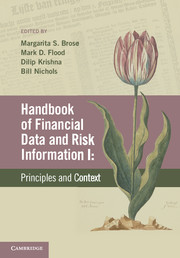PART III - REGULATORY DATA
Summary
This section focuses on the details of regulatory data, especially in the USA and Europe, slicing the topic several ways: historically, functionally, and geographically. The regulatory system in the USA is famously complex, and so US institutions receive special attention here. Regulators and government offices at all levels are an important feature on the data and information landscape for financial services. Supervisors have specific data and information challenges as they measure adherence to capital standards, implement monetary policy, estimate system-wide risk concentrations, enforce insider trading prohibitions, and perform the sundry other duties of the office. More broadly, the collected data help to define legal claims, monitor risk, enhance market transparency, resolve failing firms, and enforce the laws and rules. Regulators provide, in varying degrees, a service of centralization and cross-comparison of information. In many cases the data are published, perhaps in aggregated form, increasing transparency in the system.
Moreover, many of these information requirements cascade directly or indirectly to the financial firms that must comply with regulatory reporting mandates, thus ramifying their impact. In short, there is a “multiplier effect” to data-driven regulation. The central role of supervisory data is vital for both regulator and regulatee to understand the nature and uses to which data are put.
- Type
- Chapter
- Information
- Handbook of Financial Data and Risk Information IPrinciples and Context, pp. 381 - 384Publisher: Cambridge University PressPrint publication year: 2014



